12-18 October, 2008
Hong Kong needs a market crash every once in a while to restore the reality-delusion equilibrium. Grubby little banks that seduced senior citizens into putting their savings into nice, safe, high-yielding disasters are publicly humiliated. Property developers are forced to knock a horrifying 10% off the price of each square foot in their latest L’Beaux-Arts Hills rabbit-hutch monolith. Smug ex-civil servants who think they are gifted with measureless policy-making wisdom find themselves exposed as out-of-depth, panicky mediocrities.
But, frustratingly, some highly deserving victims apparently survive unscathed. For example, the tacky, phony, plastic, ripoff restaurants of Hong Kong’s Soho district inexplicably remain open for business. Which will be the first to go – the pretentious, cookie-cutter Cecconi’s Italian, the HK$250 sandwiches of Duke’s Burger, the dismal fake-Vietnamese of Soho Spice or the desperate Nepalese-run Argentine or Argentine-run Nepalese places on Staunton Street? It is a hard question to answer in a place where the worse the value for money, the more people like it, or at least think they do. Or think they should.
While waiting for the long-overdue and richly deserved closure of these pretentious and opportunistic insults to food-lovers, what better way to pass a few days than a trip to Macau to inspect the latest gambling extravaganzas? The first stop is the MGM Grand on the southern reclamation area of the peninsula, jointly owned by MGM Mirage and gambling king Stanley Ho’s daughter Pansy. Apart from the distinctive wavy architecture of the main hotel building and a couple of more-or-less Dali sculptures, several features stand out.
First is the glass-covered faux-Lisbon in the middle of the complex – a response perhaps to the third-floor St Mark’s Square at the Venetian. Molded concrete reproductions of the facades of the Portuguese capital’s Romanesque and Moorish-influenced buildings surround a courtyard of trees with garish plastic leaves and slightly bored-looking Filipino staff.
Inside the make-believe Rossio railway station is the casino, which the blurb says is over 220,000 square feet in size and has 385 tables and 888 slot machines. The increasingly gargantuan size of new gambling palaces – first the Sands, then Wynn, then the Venetian – leaves the occasional visitor numbed, and Pansy’s sprawling acreage probably seems less impressive than it should. As with the plaza outside, however, the most noticeable feature is the lack of people. Most of the tables are unmanned, and those that have a croupier sitting at them have a distinctly under-employed one. Along with attendants in the lobby and the usual fleet of buses offering (very useful) free rides to and from the ferry, there is an unmistakable smell of burning money.
A year or two ago, many Mainlanders could get exit permits to visit Macau as often as they wished. Then it was cut to one a month. Then one every two month. Today, though the policy has not been officially announced, they are limited to one trip every three months. Why, some senior officials in Beijing have demanded, are we letting so many citizens cross that border so frequently to hand over so many billions to American casino owners?
Strolling around the near-empty MGM – staff seem to outnumber visitors three or four to one – brings back to mind a heart-rending report from Bali published a month after the terrorist bombing in 2002. The writer interviewed a vendor of T-shirts near the beach. She stood there every day waiting for tourists that didn’t come, wondering how she was going to feed her kids. Fortunately, Pansy doesn’t have any children.
Unlike her father, whose target market is unashamedly the hard-core gambler who needs no more than cigarettes and noodles every few hours, Pansy shares the other US-influenced casino operators’ charmingly naďve aim to attract a more wholesome, family-type of clientele who want to stay in up-market accommodation, frequent absurd spas, buy endless designer-label handbags and eat every available flavour of overpriced ice-cream. Hence the Lisbon-like plaza. Hence the half-dozen 35-storey blocks of supposedly HK$3,000-a-night rooms springing up along the western edge of the place – which look set to treble the capacity of the project.
Round the corner from MGM is Wynn’s place, which has decided to be more proactive about luring the Mainlanders through the doors by offering a unique free show. Wynn already offers dancing musical fountains out at the front, complete with jets of flame bursting out of them at appropriate moments. It’s all a bit too subtle and understated for the friends from across the border, so he now has the Big Gold Musical Tree of Prosperity in the foyer at the other end of the casino.

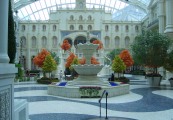





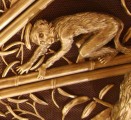

Tomorrow, I will look into rumours that Stanley Ho is showing disrespect to the Bank of China.
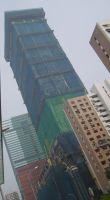
Opposite the soot-spewing trucks, the splashing concrete and the Pakistanis in hard hats working on the latest extension to the Wynn is another construction site – L’Arc. This is being developed by Stanley Ho’s number-two (three, four?) wife Angela. Yet another highly original hotel-casino-luxury apartment combination for the City of the Name of God of Macau. According to one scurrilous and untrustworthy local contact, the structure breaks the height restriction for the area after being authorized by disgraced former public works official Ao Man-long, now doing 27 years in prison. It is, indeed, located near that part of the reclamation where the buildings are all exactly the same lowish height (maybe 10 floors or so). I have always assumed that this height limit was because of the airport runway, which points roughly in this direction. Hopefully, I am wrong – though the word is that the buildings on the reclamation are sinking into the ground, so the problem could solve itself over time.
Farther along across Av da Amizade, barely 100 yards past Ho’s original, soon-to-be demolished Hotel Lisboa flagship, we find Macau’s latest example of architectural refinement and elegance – the Grand Lisboa. The casino is inside the kaleidoscope egg-shaped base, and seems only averagely substantial in size at first until you realize there’s another floor of it, and then another, and another, and so on. A few throngs of chain-smoking, phlegm-stricken, unshaven Mainlanders with huge shiny metal watches are gathered round some gambling tables, sparingly nudging chips across one at a time, but it is still 90% empty. Unlike at Pansy’s place, every expense has been spared on vaguely tasteful fripperies and allusions to cultural splendor. The emphasis is on economical but loud glitz and gaudiness, along with a fetching bust of Stanley Ho and the world’s biggest diamond (of a particular type – cushion-shaped, D-colour, don’t ask) called… Star of Stanley Ho.
Back in the mid-90s, tycoon Li Ka-shing wanted to build a mega-tower in Hong Kong’s Central district on the site of the old Hilton Hotel. Just as work was about to begin, so the legend goes, he got a call from the Bank of China next door. We do assume, they gently reminded him, that your new block will not be taller than ours, hmmm? Thus the patriotic Li supposedly pushed a last-minute redesign that involved reducing the height of each storey – to cram more floors in – and ending up with the boring rent-maximizing, box-shape Cheung Kong Center we know today.
Stanley Ho is made of sterner stuff. It seems he deliberately ordered his giant concrete-and-glass edificio to exceed the height of the Bank of China’s Macau HQ over the road. Piqued, the Mainland financiers ordered a big BoC logo to be added to the top of their tower to win back their cherished status as tallest kid for three blocks around. Ho responded with a strange DNA-style double helix attached to a lobster pot to show them who’s boss.
The building is supposed to represent a lotus flower. Dennis Lau & Ng Chun Man Architects of Hong Kong have owned up.

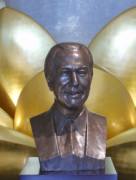




One of the new, classy, highly professional innovations American investors have brought to the Macau scene is the word ‘gaming’. It conveys an image of harmless amusement – kids playing hopscotch, perhaps. No money-laundering, no loan sharks, no high-stakes VIP agents slumped over the steering wheel of a car in Zhuhai with a bullet in the head, no Gold Bauhinia Star tycoon named in Royal Canadian Mounted Police investigations or US State Dept reports on narcotics and law-enforcement for possible triad links. Just good, clean, wholesome gaming.
In addition to Pansy and Angela, Stanley has (if I recall correctly) 16 children and two wives still living, plus at least one troublesome sibling. If just a small percentage of these are dabbling in casino development – which indeed they are – the curious visitor to Macau could while away days pondering the Ho family’s intriguing contributions to the architectural and economic wonders of the gaming industry.
But Hong Kong awaits, and I have yet to indulge in the highlight of every visit to Macau – a meal at a Portuguese restaurant that isn’t Fernando’s. Macau used to be very different. A narrow causeway linked Taipa and Coloane islands, if you took a wrong turn down there you ended up in a leper colony, the Bella Vista was a fleapit hotel overlooking the sea, and the ferry terminal was a big, sweaty shed. Fernando’s started off as a well-kept secret but gradually became popular, to the extent that today ruddy-faced British families from Hong Kong clog the place up, perhaps reliving cheap drunken trips to Spain’s Costa Brava. It is fashionable to dismiss it, though the food and beach are no doubt much the same as ever. A Lorcha has become popular, too, and is often swamped with waitress-straining busloads of Mainland and Japanese groups.
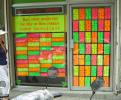


The World’s Freest Economy bites the dust. What The Economist described as recently as the 1990s as ‘a great libertarian experiment’ finally succumbs to its post-colonial leaders’ small-mindedness, as Chief Executive Donald Tsang plumps for a minimum wage in the annual Policy Address. He follows this attention-grabbing heresy with forgettable but in some ways more revealing blather about enhancing the public’s understanding of social enterprises. In theory (and in practice in the US or UK), these are small companies run by grassroots folk as part of self-help – indeed anti-officialdom – initiatives. In Hong Kong, they are funded and organized top-down by bureaucrats eager to send a subliminal message to the population that corporatist governance is their only hope. It is with absolutely no awareness of irony that Sir Bow-Tie declares…

But is the Big Lychee’s tragic decline inevitable or irreversible? Or will the forces of incompetence collapse under the weight of their own contradictions. For example… Since Islamic finance is partly about avoiding investments involving evils like alcohol, and since no-one is going to store booze in a place full of mullahs hurling fatwas at any economic activity not compliant with Sharia law, could it be that those two hub projects will just cancel each other out? Then the Government could go back to what it is supposed to do – keep the sewers clean – and let free enterprise and market forces decide what sort of hub the Big Lychee should be. Meanwhile, back on planet Earth…
I had to look it up, but he’s right – there is such a thing. It came into existence well over a year ago at one of those functions where they helpfully have a large backdrop on the stage reminding you that this is a signing ceremony you are attending. My first suspicion is that the SZ-HK Innovation Circle is sort of like the Colgate Ring of Confidence – something meaningless we can nonetheless smile about. But on closer inspection it looks more like a division-of-labour agreement.
The deal seems to be that Shenzhen, with its reasonable business costs and access to millions of smart, ambitious and resourceful Mainland science graduates, will do lots of interesting research and invent groundbreaking applied technology that makes life healthier, richer and more fulfilling for mankind. Then, when interested foreign customers come around to buy some, Hong Kong will stop picking its zits, leap smartly to its feet, wedge itself between the two parties and demand a 15% cut on the transaction for being so useful and adding value with its good international connections and not-bad English.
Alternatively, it’s one of those embarrassing charades where Mainland officials try to con us out of our reserves – plus any skills and contacts they see lying around – by pretending to offer some tempting-sounding ‘partnership’ or ‘cooperation’, and the Hong Kong Government plays along in order to appear patriotic and committed and not at all stuck-up, and really positive about having hundreds of grasping, corrupt scumbag mayors and county secretaries lingering on the doorstep. In which case, the documentation will be in Chinese only, since no-one on this side of the border will ever read it.
On the subject of which …
Determined to look on the brighter side, I note two features of the Policy Address that give at least some cause for optimism. First – perusing the whole document, it seems that the administration’s previously announced plan to phase people out completely and replace them with ‘sectors’ and ‘human capital’ has been put on hold. Secondly…
Fri, 17 Oct
On Wednesday, radical lawmakers Leung ‘Long Hair’ Kwok-hung and Wong ‘Mad Dog’ Yuk-man launched a pincer-style heckling assault on Sir Bow-Tie in the Legislative Council, culminating in what passes in sleepy Hong Kong as an assassination attempt, with a well-hurled though poorly aimed piece of fruit. Now, defiantly sporting a banana-proof vest, Donald comes back to Legco for interrogation about his use of the phrase ‘third way’.
I always thought it referred to a communitarian, Blair-Clinton, warm, cuddly and fuzzy politics that enables mighty tycoons, lowly truck drivers, young and old, greedy and generous, exploitative and charitable, plus the bunny rabbits and the trees to be one big happy family and not squabble. Thus, in the Hong Kong context, it would mean, for example, enforcing tighter standards on vehicles and power stations to reduce air pollution, or giving the elderly poor a bit more cash so they don’t have to pick through garbage so often – but not too much. It’s all about avoiding extremes. You don’t want absolutely poisonous fumes in your lungs or starving senior citizens dying in the streets, but you don’t want really clean air or seriously well-fed old folk, either.
However, the South China Morning Post describes the ‘third way’ for the benefit of its dimmer readers as “a compromise between socialism and Communism.” By socialism, they obviously mean the sort that has Chinese characteristics – From each according to his ability to each according to his unlicensed coal mine, melamine-tainted milk factory or luxury development on stolen farmland. It pretty much sums up the Hong Kong way. It’s not capitalism. Half the population live in state-subsidized homes, and cartels cheat consumers. But neither is it Proudhonism. People are too busy playing with their Hello Kitty mobile phone with 8 megapixel camera and 4 gigabytes of Cantopop to shout out ‘property is theft’.
Blessed with a ‘Line to Take’ crafted by some political assistant in an opium-induced reverie where vague and happy fancies are hard, convincing facts, Donald mesmerizes his critics with mantras. “…address squarely the challenges ahead with effective crisis management… turn crises into opportunities.” So ‘crisis’ management turns into ‘opportunity’ management. And that’s it in a nutshell. Recession coming? We will tighten land supply to ensure people still have opportunities to make big margins from tiny concrete boxes. And we will drag our feet on a competition law to ensure people still have opportunities to make big margins from nasty groceries. And we will throw huge budgets at white-elephant projects to ensure people still have opportunities to make big margins from construction and engineering contracts. Bingo – we “balance the various interests of society.” That’s what the ‘third way’ is all about.
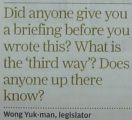

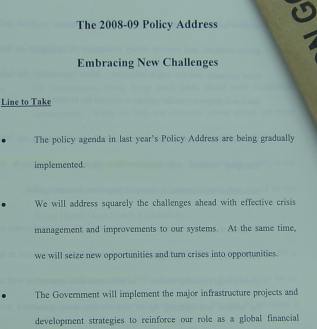
stores
Dymocks, IFC Mall
& other HK Dymocks
(some, probably, maybe)
online
Hong Kong & worldwide
USA & worldwide
UK
Canada
Germany
Japan
France